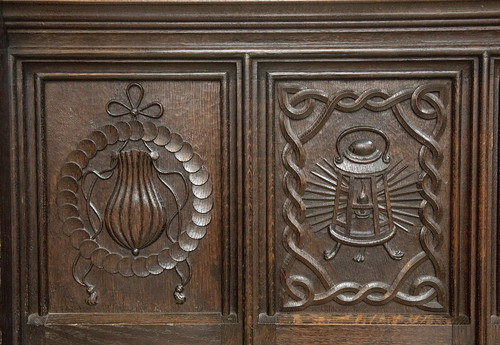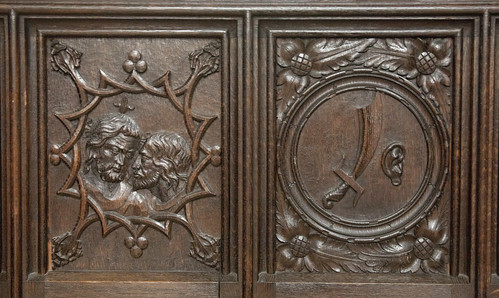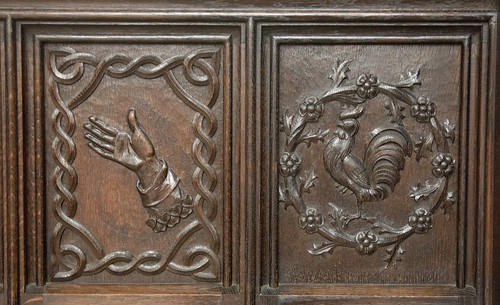 |
| Judas' payoff, and a lamp for those going to arrest Jesus in the Garden of Gethsemane |
1: Leon Podles' argument about masculinity.
2: How Podles thinks the Church became feminised in the High Middle Ages
3. Doubts about Podles' historical argument.
4. The role of Rationalism and Romanticism in confirming the feminine image of the Church.
5. The liturgy, and a solution to the problem.
I think this is an immensely important issue, so I'm going to devote a few posts to it; this one, and then some more after Christmas. In this one, I'm just going to give Podles' most basic claim, about how masculinity works. It is quite simple, fits into many obvious facts about culture, and has huge implications.
It can be expressed in three easy steps.
1. In order to attain some standing, respect or acceptance in a community, an individual needs to make some kind of contribution to it. Especially valued, obviously, are valuable contributions make at the cost of great effort, pain, and risk to life.
2. Women are able to make such a contribution in a way which is not open to men: through childbirth. This isn't all they can do, obviously; what is important is that it is not open to men. Men can't give birth. In the normal course of things most women who reach adulthood will go through childbirth, and even today this is a very big deal in terms of effort, pain, and risk. Their contribution to the community, and the community valuing them as a result, is assured in this way. To an extent, even the possibility of childbirth puts women through pain and bloodshed: again, this is not something open to men.
 |
| Judas' kiss; St Peter's sword and the severed ear. |
That's the argument. Everything you've ever heard about 'girly' men makes sense in this context. In this context men have (in some sense) a fear of being subsumed by the female realm, because that would be the end of their self-understanding as men and the respect and value they attain as men. Masculinity, manhood, is in this sense not a biological inevitability, but an achievement; it is achieved by the kinds of experiences which can be described as initiations. Risk to life and limb in hunting and in warfare are the most obvious examples, but of course it can take many forms. This kind of risk-taking activity is something for which men are both equipped physically and mentally, and disposed to. Even tiny boys display behaviour connected with it. As a matter of objective fact men are overwhelming represented in high-risk professions and sports.
This kind of biological, psychological, and sociological fact is something which we ignore at our peril. Podles' next argument is that the Catholic Church in the West, and the Protestant churches, have become 'feminised' to the extent that men fear that close association with them is a threat to their hard-earned masculinity. And that this is why Christian church congregations in the West typically contain more women than men.
 |
| The hand which strikes Jesus before Caiaphas; St Peter's cockerel. |
Support the work of the LMS by becoming an 'Anniversary Supporter'.
"Podles' next argument is that the Catholic Church in the West, and the Protestant churches, have become 'feminised' to the extent that men fear that close association with them is a threat to their hard-earned masculinity".
ReplyDeleteAn interesting idea but if that is the case then the problem is far from being a modern one. St John Vianney found the same problem at Ars where, "most of the men refused to make their Easter Duty. . . The Church had some women but only a few men" (The Cure of Ars - Father Bartholomew O'Brien - Tan Books - 1956).
Similarly, Our Lady stated at La Salette, "Only a few old women go to Mass; in the summer, the rest work all day Sunday and in the winter, when they are at a loose end, they only go to Mass to make fun of religion"
Podles argues that the seeds for the problem were planted in the middle ages, but only came to sprout during the baroque and modern eras.
DeleteIndeed, "an immensely important issue". Some years ago I used to count - in different circumstances, but especially at morning Novus Ordo Masses - the number of women and men who attended. Usually, the ratio was something like 14:1. In other words, when 14 women were there just one man was present. But this cannot be perfectly accurate, of course. What matters is the fact that ALWAYS, I repeat - ALWAYS - women were (and are) much more numerous than men. I asked about this issue some priests and monks. In different occasions I received a significant answer: the main reason behind this disproportion is the impurity due, especially, to pornography. I think that this, indeed, can be the main reason for the destruction of manhood and of that crucial virtue related with it: "andreia" (Gr. ἀνδρεία). And this is the point which I want to emphasize: it is really hard to find nowadays, in our parish churches, any type of education to a virtuous life. As a Catholic catechist I asked many times the participants at our first meetings to name at least 3-4 virtues. Few of them were able to name 2.
ReplyDeleteWell wait and see what Podles offers as an explanation.
DeleteI don't think pornography fits. The current problem of ubiquitous on-line porn is certainly a scourge, but the problem of the missing men goes back to beyond the internet existed.
Yes, I agree.
Delete(Anyway, one of those priests who gave me the explanation based on "impurity" emphasized the rejection of the Sacred from the part of impure persons. And - simultaneously - the rejection of the "impure" by the Sacred.)
In any case, I am really eager to read your complete explanation...
This is a profound and complex issue, now out in the open at last.
ReplyDeletePodles work is something I did not know of, and requires study.
That the Catholic Church has become “feminised” in the last fifty years is obvious to anyone who has eyes to see and is disturbing to men as well as to many women, something we should not ignore. Homosexuality or the balance thereof, is a major factor in this.
I look forward to your future posts.
Male attendance at Mass often struggled in the old days - the tales of Irish and Spanish men loitering outside the church until time for Communion are not entirely apocryphal.
ReplyDeleteBut the liturgy has since been feminized to the point where male attendance which might have struggled to stay in the 40% range is now a heck of a lot lower, especially in the 18-35 age cohort. Yet so many of our clerics and evangelization committees seem uninterested in addressing this dearth of men in the Church.
I am indebted to Joseph for linking the Leon Podles' book; I had not gotten round to it, and wasn't aware that it was available for free online. There's tremendous insights into Christianity and gender in there, and I urge others here to take the time to read it, too.
ReplyDeleteTwo passages in the introduction really hit home as quite accurate about many Catholic priests of the last few - several? - generations:
"The clergy have the most direct, practical interest in the [disappearance of men] situation, and they have shown a remarkable lack of concern. I suspect that the clergy are not unhappy with the absence of men. Women are easier to deal with than men would be. Even feminists can be satisfied to some extent."
Another reason for this disinterest is given in the other passage:
"Because Christianity is now seen as a part of the sphere of life proper to women rather than to men, it sometimes attracts men whose own masculinity is somewhat doubtful. By this I do not mean homosexuals, although a certain type of homosexual is included. Rather religion is seen as a safe field, a refuge from the challenges of life, and therefore attracts men who are fearful of making the break with the secure world of childhood dominated by women. These are men who have problems following the path of masculine development[.]"
It strikes me that there has been an uptick, finally, in the quotient of more apparently "masculine" priests in America in the past generation, at least - an uptick much less in evidence in most of Europe, alas, outside of traditional societies or orders. Therein hangs more than one tale, not least in how different episcopates behaved at the recent Synod.
This comment has been removed by the author.
ReplyDelete